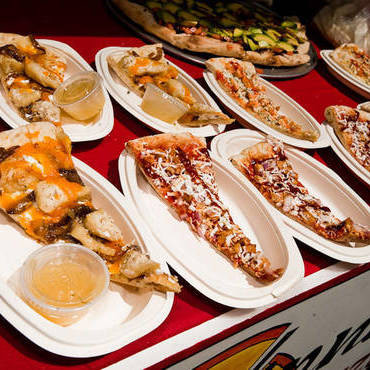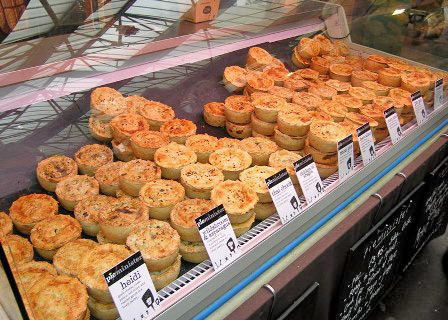Occasional miscellany: All that’s old is new again.
According to The New York Times, Vinnie’s is a tiny old pizza parlor in Brooklyn (Williamsburg: where else?), its character somehow preserved but also reimagined by recent buyers. Vinnie’s engages in spectacular culinary innovation that extends beyond the decorative as well as gustatory even to its packaging. It also, according to the Times, “has an outsize online footprint.”
People like the taste of the pizzas, but it is their appearance that generates so much social media. Favorite images include the “Mini Vinnie, a slice covered in tiny pizza slices, a purple slice in honor of Price; and a rainbow slice to celebrate the Supreme Court affirmation of the right to gay marriage.
None of that, apparently, is enough to satisfy the imagination of the enterprising proprietors of Vinnie’s. They now offer “a pizza box fashioned out of pizza crust” and its depiction is viral. According to Katie Rogers, the Times reporter who wrote “At Vinnie’s, You Can Grab a Slice, Then Eat the Pizza Box,” it “sounds like the kind of creation dreamed up in a stoner haze” even though Sean Berthiaume, the inventor of the ‘box,’ insists “he may be the ‘only person in Williamsburg who doesn’t smoke marijuana.’”

Some of Vinnie’s more conventional slices.
It sounds to us more like the creation dreamed up long ago in another kitchen. All this other than the weed leads back at least as early as seventeenth century England. Packaging food in something edible is nothing new: It accounts for the origin of pie. When cooking vessels cost a lot of money, and before the advent of utensils, encasing food in an edible crust kept down cost.
Pies predate sandwiches by a century or more and are just as handy for eating with the hands. As Elisabeth Ayrton has written in “The Tradition of the Savoury Pie,” they “evolved as a splendidly convenient way of eating meat in gravy before the fork was in general use: a cold pie where the stock was jellied was, of course, particularly easy to eat with the fingers.” (Ayrton 85)
It took no time for people to realize that a “coffin” as it was called also concentrated the flavor of the filling in a wonderful way, not an attribute of the ‘box’ from Vinnie’s, but as the adage goes you can’t have everything, not all the time anyway.
Gervase Markham, one of the great cookbook authors working in the English idiom, declared that “[t]here are [sic] a world of other bak’d Meats & Pies, but for as much as whosoever can do these, may do all the rest, because herein is contained all the art of seasonings, I will trouble you with no further repetitions.” (quoted at Ayrton 85)
“When Gervase Markham wrote this in 1615,” Mrs. Ayrton explains, “it was inconceivable that the table at any feast, or any grand occasion, should be without its pies and pasties.” And as she insists, [t]he meat pie attained its perfection only in England and held its pride of place from the Middle Ages until the nineteenth century.” (Ayrton 85)

Savory pies also spread throughout the Anglophone world, though oddly enough not nearly so much elsewhere, and they proliferated in style and content as well as quantity.
Encasing a filling in crust also made it portable, and pies predate the sandwich by over a century. The most famous example of portable pie may be the Cornish pasty. As Jane Grigson explains in English Food, a miner could take with him to work a single serving pasty (bigger ones, which have fallen from favor, used to be made for family dinner) with a thicker crust than the case ordinarily baked for eating at home. The pastry was so robust our miner could put the pasty in his pocket.
The pie is versatile, and if the miners’ wives of Cornwall did not dye their pasties purple, they did reduce the proportion of meat to vegetables or dispense with it altogether in favor of cheese when times were tough. They also customized their pasties to suit the occasion, in a way similar to but different from Vinnie’s. “Traditionally,” Mrs. Ayrton explains,
“Cornish pasties had the initials of each person intended to eat one marked on one corner. In this way, onion could be omitted if someone disliked it, extra meat put in for the master of the house and so on. Fishermen, eating in their boats, would hold the initialed corner and start biting at the other end. If the pasties had to be hastily put down in some emergency, everyone would know his own.” (Ayrton 118)
They also were unencumbered by packaging, and to indulge in an anachronistic turn, would have found approval from the twenty first century green movement no less than the pizza dough box from Williamsburg.
We wish Vinnie’s well.
Sources:
Elisabeth Ayrton, The Cookery of England (London 1974)
Jane Grigson, English Food (London 1974)
Katie Rogers, “At Vinnie’s, You Can Grab a Slice, Then Eat the Pizza Box,” The New York Times (15 May 2016)

